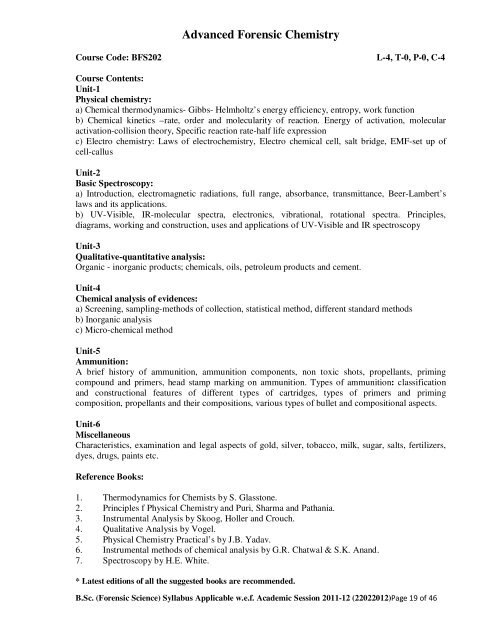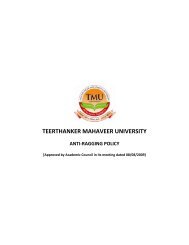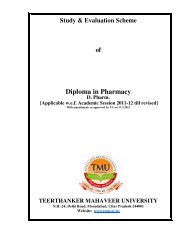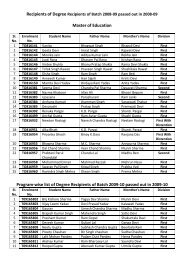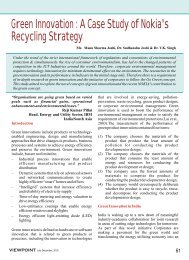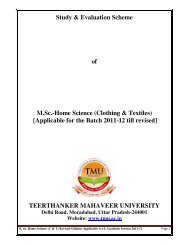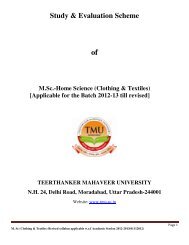Study & Evaluation Scheme of Bachelor of Science in Forensic ...
Study & Evaluation Scheme of Bachelor of Science in Forensic ...
Study & Evaluation Scheme of Bachelor of Science in Forensic ...
You also want an ePaper? Increase the reach of your titles
YUMPU automatically turns print PDFs into web optimized ePapers that Google loves.
Advanced <strong>Forensic</strong> Chemistry<br />
Course Code: BFS202 L-4, T-0, P-0, C-4<br />
Course Contents:<br />
Unit-1<br />
Physical chemistry:<br />
a) Chemical thermodynamics- Gibbs- Helmholtz’s energy efficiency, entropy, work function<br />
b) Chemical k<strong>in</strong>etics –rate, order and molecularity <strong>of</strong> reaction. Energy <strong>of</strong> activation, molecular<br />
activation-collision theory, Specific reaction rate-half life expression<br />
c) Electro chemistry: Laws <strong>of</strong> electrochemistry, Electro chemical cell, salt bridge, EMF-set up <strong>of</strong><br />
cell-callus<br />
Unit-2<br />
Basic Spectroscopy:<br />
a) Introduction, electromagnetic radiations, full range, absorbance, transmittance, Beer-Lambert’s<br />
laws and its applications.<br />
b) UV-Visible, IR-molecular spectra, electronics, vibrational, rotational spectra. Pr<strong>in</strong>ciples,<br />
diagrams, work<strong>in</strong>g and construction, uses and applications <strong>of</strong> UV-Visible and IR spectroscopy<br />
Unit-3<br />
Qualitative-quantitative analysis:<br />
Organic - <strong>in</strong>organic products; chemicals, oils, petroleum products and cement.<br />
Unit-4<br />
Chemical analysis <strong>of</strong> evidences:<br />
a) Screen<strong>in</strong>g, sampl<strong>in</strong>g-methods <strong>of</strong> collection, statistical method, different standard methods<br />
b) Inorganic analysis<br />
c) Micro-chemical method<br />
Unit-5<br />
Ammunition:<br />
A brief history <strong>of</strong> ammunition, ammunition components, non toxic shots, propellants, prim<strong>in</strong>g<br />
compound and primers, head stamp mark<strong>in</strong>g on ammunition. Types <strong>of</strong> ammunition: classification<br />
and constructional features <strong>of</strong> different types <strong>of</strong> cartridges, types <strong>of</strong> primers and prim<strong>in</strong>g<br />
composition, propellants and their compositions, various types <strong>of</strong> bullet and compositional aspects.<br />
Unit-6<br />
Miscellaneous<br />
Characteristics, exam<strong>in</strong>ation and legal aspects <strong>of</strong> gold, silver, tobacco, milk, sugar, salts, fertilizers,<br />
dyes, drugs, pa<strong>in</strong>ts etc.<br />
Reference Books:<br />
1. Thermodynamics for Chemists by S. Glasstone.<br />
2. Pr<strong>in</strong>ciples f Physical Chemistry and Puri, Sharma and Pathania.<br />
3. Instrumental Analysis by Skoog, Holler and Crouch.<br />
4. Qualitative Analysis by Vogel.<br />
5. Physical Chemistry Practical’s by J.B. Yadav.<br />
6. Instrumental methods <strong>of</strong> chemical analysis by G.R. Chatwal & S.K. Anand.<br />
7. Spectroscopy by H.E. White.<br />
* Latest editions <strong>of</strong> all the suggested books are recommended.<br />
B.Sc. (<strong>Forensic</strong> <strong>Science</strong>) Syllabus Applicable w.e.f. Academic Session 2011-12 (22022012)Page 19 <strong>of</strong> 46


